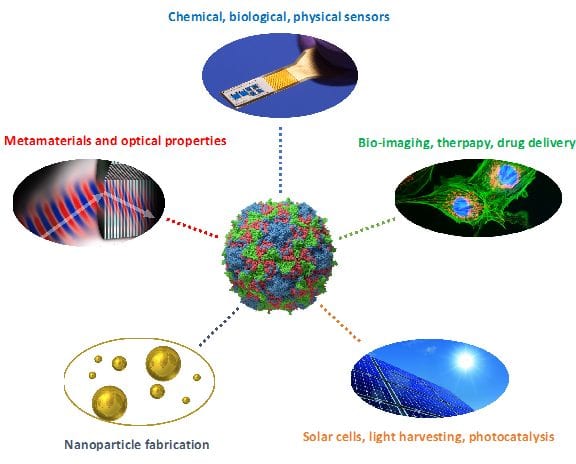With the advent of nanotechnology, it has become clear that physical phenomena at the nano-scale behave differently than at the bulk scale. Over the last decade, this has prompted the fabrication of ever smaller material building blocks with the aim of developing novel functional materials. The sizes, shapes, arrangements, and chemical identities of these nano-objects tune the physical properties of the materials they constitute.
More recently, the design of nano-scaled objects with photonic or plasmonic properties has enabled the miniaturization of optically-active materials and devices. Specifically, it is the arrangement, orientation, or self-assembly of optically-active building blocks that confer the desired optical properties to the materials. For example, it is the spacing between nano-antennae controlled by a scaffold that drives efficient electromagnetic energy transfer in light harvesting systems, while it is the scaffolding of plasmonic nanoparticles that can reveal unique spectroscopic features of target molecules in sensor devices. It is the shape and orientation of nano-wires that improves energy conversion efficiencies in solar cells.
The self-assembly of plasmonic nanoparticles into 3D can produce metamaterials that possess optical properties not observed in Nature, while the self-assembly of nano-blocks lacking optical properties can produce hierarchical structures that interact with electromagnetic radiation in a way that enables detection of trace amounts of volatile solvents or explosives. More surprisingly, the biocompatibility of some nano-blocks facilitates their use as biological imaging platforms and therapeutic agents when coupled with dyes and nanoparticles and injected in animal bloodstreams. All of these applications require an appropriate nanoscale scaffold that can enable the desired functionality.
The protective shell of viruses, also known as capsids, fulfill all of these requirements. Capsids can produce functional optical materials by scaffolding, encapsulating, and self-assembling photonic or plasmonic material. Additionally, they benefit from unique biocompability by virtue of their proteinaceous composition. Taken together, these properties make capsids ideal nano-size building blocks for the fabrication of photonic and plasmonic materials and devices spanning nanomedicine, energy transfer and conversion, and sensors. Find out about the fascinating applications of viruses in the world of nanotechnology! Read a new review article in WIREs Nanomedicine and Nanobiotechnology, “Viral-based nanomaterials for plasmonic and photonic materials and devices.”

















